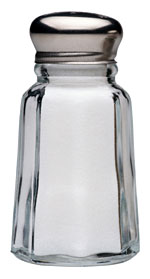This article is brought to you by our Biggest Loser newsletter sponsors – The Biggest Loser Resort at Fitness Ridge.
I have been thinking about salt lately, and the negative health effects of having too much sodium in the diet. A high intake of sodium can raise blood pressure and increase the risk for heart disease and strokes. On the whole, Americans get too much sodium, ingesting an average of 3,500 mg per day instead of the recommended 2,300 mg per day. Interestingly, the majority of our sodium comes not from salt added at the table, but from processed and pre-packaged foods.
I am excited to see that there have been some recent developments relating to cutting sodium intake in the US. Last month, the Food and Drug Administration (FDA) announced its plans to decrease salt in the American diet. They are looking to limit the amount of sodium in restaurant meals and prepared/processed foods, starting with voluntary cutbacks by restaurants and food manufacturers. So far, 16 companies have signed on to start reducing sodium in their products. Companies like Starbucks, Subway, and Boar’s Head have said they will cut sodium by 25 percent in five years. Heinz has said they will decrease the sodium in their ketchup by 15%. And others are following suit.
Although this is a huge step in the right direction, it will take a while to come into effect. So what can we be doing today to decrease our sodium consumption? Here are a few tips to help kick the salt:
• Use less processed foods – try to use more fresh ingredients when you can
• Read food labels to look for low or reduced sodium products (140 mg or less per serving is a low-sodium product)
• At the deli counter, look for reduced or low-sodium options
• Don’t salt a dish without tasting it first
• Remove the salt shaker from the table to keep from automatically reaching for it
• Substitute other herbs and spices in place of salt
• Use lemon juice and/or vinegar in place of salt
For more ideas about how to use various herbs and spices in place of salt, check out this article. If you want more information about the FDA’s proposed plans to decrease sodium, this article as well as this article are insightful.
Remember, when you start reducing your sodium intake, it can take a while to get used to the flavor of food without salt. Don’t give up too soon. Stick with it, and you’ll start to find joy in the natural flavor of foods.
– Rachel Cope MPH, RD, CD

